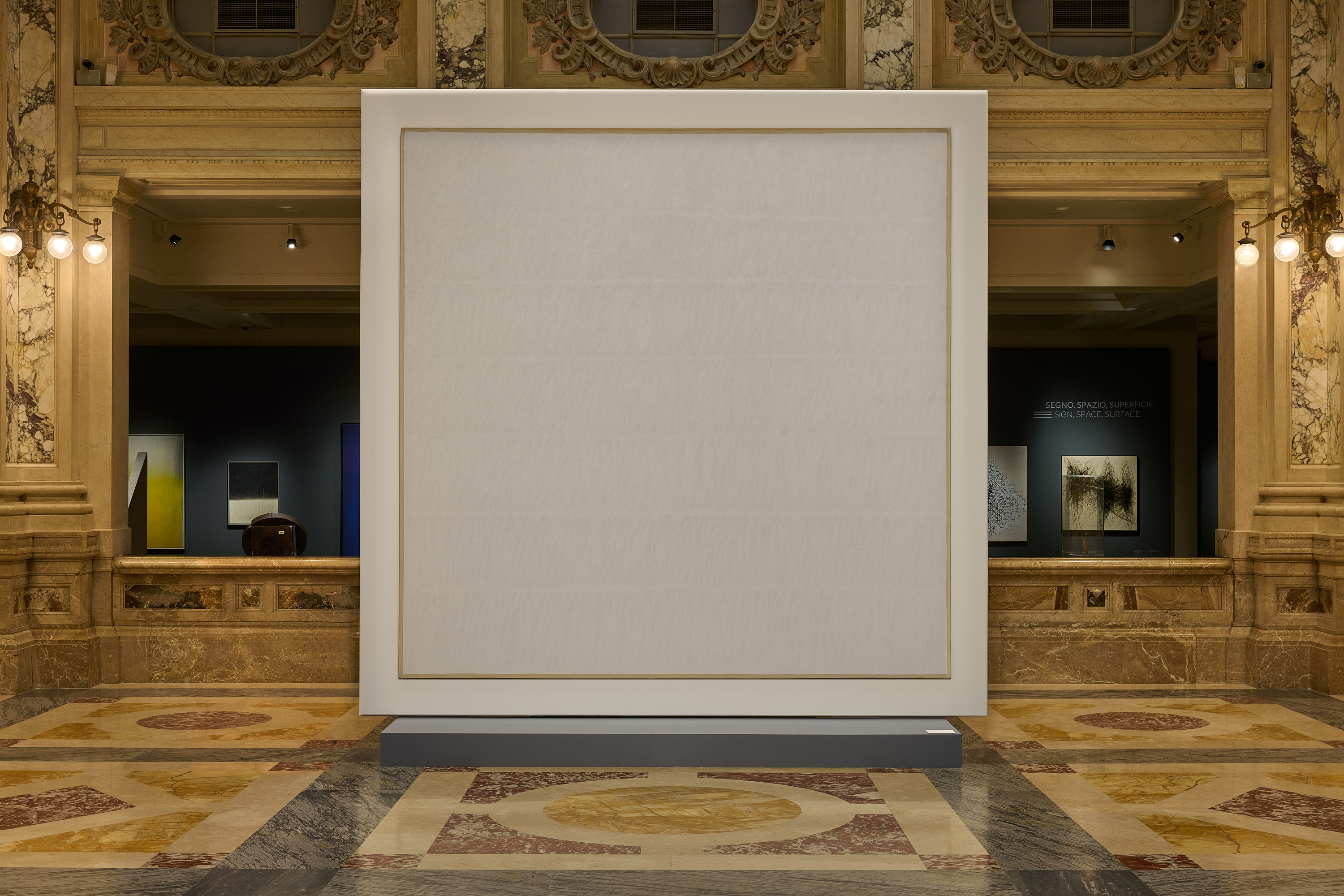Robert Ryman "Surface Veil IV" from Luigi and Peppino Agrati Collection
Gallerie d'Italia - Milan
From 6 October 2024
The new setting that enriches the exhibition itinerary dedicated to the collection of modern and contemporary art of Intesa Sanpaolo Group
As part of its ongoing activity of studying and sharing Intesa Sanpaolo's modern and contemporary art collections, Gallerie d'Italia presents to the public for the first time an extraordinary painting by Robert Ryman from the Luigi and Peppino Agrati Collection.
An encyclopaedic collection of contemporary art built up between the 1960s and the 1980s and brought together, thanks to the legacy of Cavalier Luigi Agrati, in the historical-artistic heritage protected and exhibited by the Bank, the Collection comprises a total of ten works by Ryman, including the 1966 masterpiece Winsor 20, kept in the vault of this museum, open to visitors by reservation.
The painting presented here belongs to the Surface Veil series, created by Ryman between 1970 and 1972, and named after a brand of very thin fibreglass, used as a support in the first works of the cycle, some of which were exhibited for the first time in 1971 at the Dwan Gallery in New York. The aim of the entire series is to achieve the greatest possible adhesion of the work's surface to the wall using a very thin support.
The adhesion to the wall is part of the process of physical objectification of painting pursued by Ryman, which the artist defines in terms of an authentic “realism”, free from external associations and therefore “absolute”, as opposed to the ‘abstraction’ of any representative image: “We have been taught to see painting as ‘figures’, with either abstract or literal narrative connotations, in a space that is generally limited and enclosed by a frame that isolates the image. It has been shown that there are other possibilities besides this way of seeing painting”.
The work on display belongs to the second group of the series, consisting of four larger works, which use different supports (linen or cotton, no longer fibreglass) and are differentiated by their progressive titling ? with Roman numerals. The other three examples are now at the Solomon R. Guggenheim Museum in New York. Surface Veil IV was painted on cotton canvas and consists of seven bands of brushstrokes, divided by the interruption of the layer of paint, corresponding to a change in the direction of the brushstroke. The painting bears witness to Ryman's investigation into painting materials and methods, which often leave traces of the process of creating the work, such as the mark of the tape he applies to the corners of the canvas to keep it attached to the wall: “When I start, I am never sure what the result will be. The process is actually doing the painting, that's all.”
Work by Robert Ryman
Photograph of the setting of "Surface Veil IV" by Robert Ryman
Robert Ryman. Biography
Robert Ryman was born on May 30, 1930, in Nashville, Tennessee. In 1949 he enrolled at the George Peabody College for Teachers in Nashville, where he studied music. In 1950 Ryman enlisted and was assigned to an army reserve band during the Korean War. In 1952 he moved to New York. He took a position as a guard at the Museum of Modern Art in 1953 and during that year made his first paintings. In 1955 Ryman began what he considered his earliest professional work, a largely monochrome painting titled Orange Painting. In the late 1950s Ryman became friends with artists Dan Flavin and Michael Venezia, both of whom were also working at the Museum of Modern Art. In 1961 he began to paint on a full-time basis. During the early 1960s Ryman spent time with other artists whose studios were on the Bowery, including Tom Doyle, Eva Hesse, Sol LeWitt, and Sylvia and Robert Mangold. At this time Ryman began executing his first paintings on metal, a support he went on to employ frequently. hroughout his career Ryman isolated the most basic components of painting and experimented with their variations. In 1994 Ryman was elected a member of the American Academy of Arts and Letters and assumed the role of Vice President in 2003. Robert Ryman died in New York on February 8, 2019.


